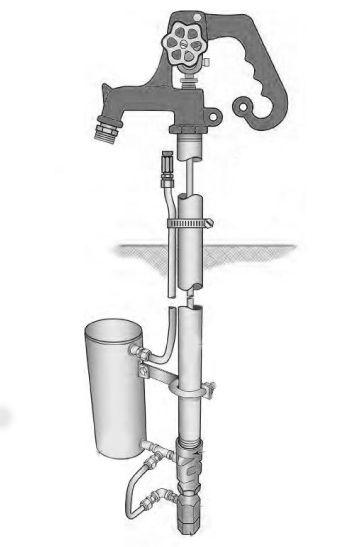Avoiding food safety issues with frost-free hydrants
Choosing the right frost-free hydrant can reduce food safety risks in the water they emit. Learn the problems of a typical frost-free hydrant and tips on how to avoid them.

Frozen pipes are always a concern for northern climate fruit and vegetable growers who need to keep a cost-effective supply of water in various places on their farm. Often, growers turn to frost-free hydrants to meet those needs and avoid a broken supply line. Unfortunately, many frost-free hydrants are vulnerable to a sanitation risk, owing to their construction.
A typical frost-free hydrant has a check valve followed by a weep hole below the frost line. When the hydrant is open, the water forces the check valve open and water flows out. When the hydrant is closed, the drop in pressure caused by the interruption of flow forces the check valve closed and the water flows out of the weep hole into the gravel casing below the frost line.
These weep holes are an open hole in the water line that is in direct contact with dirt and the ground. This weep hole is similar to if you were to lay a connected water hose in a puddle on the ground. Dirty water could potentially siphon up into the water source.
Sanitary frost-free hydrants do exist. In a sanitary frost-free hydrant, the water evacuates to a protected chamber that sits below the frost line. This allows the water level to fall below the frost line without an opening for water that might be in the soil.

Sanitary frost-free hydrant. Photo courtesy of Simmons Manufacturing Company.
A sanitary frost-free hydrant is indeed more food safe than a standard frost-free hydrant, but the level of benefit is currently unknown. That’s why it’s important to assess all risks on your farm first before investing in new hydrants. It’s best not to replace existing systems when prioritizing food safety dollars on improving infrastructure, like installing sanitary frost-free hydrants that will provide an unknown level of risk reduction. Definitely consider installing sanitary frost-free hydrants in new construction and when the current system requires replacing due to wear and tear.
When installing any new hydrants, check your state laws regarding using sanitary frost-free hydrants. In a number of cases, states not only require all frost-free hydrants to be sanitary frost-free hydrants, but they also specify particular models.
If you have specific questions about the food safety of frost-free hydrants and compliance with the Produce Safety Rule or have difficulty understanding if you comply, contact the Michigan State University Extension Agrifood Safety Work Group at gaps@msu.edu or 517-788-4292.
Funding for this article was made possible, in part, by the Food and Drug Administration through grant PAR-16-137. The views expressed in the written materials do not necessarily reflect the official policies if the Department of Health and Human Services; nor does any mention of trade names, commercial practices or organization imply endorsement by the United States Government.



 Print
Print Email
Email




